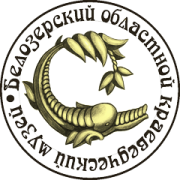Letters from the past. Spinning wheel inscriptions
Probably, no object in the wood collection is such a rich material for research as a spinning wheel!
It is a beautiful ancient household item. The history of its appearance and development is curious. The spinning wheel was used to spin threads several centuries ago. A columnar spinning wheel is depicted in the Annunciation scene on the royal gates of the Trinity Cathedral of the Trinity Lavra of St. Sergius. The iconostasis dates from 1420.
For a long time, each region, province, and sometimes even a village formed its own type of spinning wheel. The classification of spinning wheels was compiled by researchers at the beginning of the 20th century. Even then, ethnographers noted the diversity of shapes and the beauty of this extraordinary tool. Shapes of blades and legs, earrings and shoulders on the blades, through and trihedral-notched carving, brush painting – all these ways of decorating spinning wheels are described in the works of A.A. Bobrinsky, O.V. Kruglova and many experts in the field of arts and crafts.
The collection of the Belozersk Regional Museum of Local Lore includes more than 100 spinning wheels which belong to the northern type. They were received by the museum from the territories of Belozersk, Babaevo and Vashkinsky districts. Moreover, spinning wheels came from neighboring regions both after expedition trips and after their owners moved to our region.
In this work, we will give a description of the inscriptions – their methods, types, purpose, role in the study. (Any researcher is interested in an object with initials, inscriptions, deeds. Autographed books, books with its author's notes, photographs with deeds, any utilitarian object provided with information becomes much more valuable and significant.)
There are inscriptions on 46 spinning wheels in the museum collection. The inscriptions are made in 2 ways: they are either cut and/or scratched or applied with paints. Most often, blades, their inner and outer sides, are used for inscriptions. In some cases, risers or legs are used, very rarely – bottoms (seats).
V.A. Mazaletskaya, a researcher from the Kirillo-Belozersky Museum, studying the collections of wooden items and fabrics, divided the handiwork inscriptions into several groups: informational inscriptions, explanatory inscriptions, verbal folklore texts.
Information inscriptions are divided into several types:
- letter or groups of letters (initials);
- last names;
- dates;
- mixed.
Spinning wheels with letters. Letters are applied by groups: by one, two, or three letters, sometimes they are divided by dots:
265 D-56: А on the leg ГОСКАТАЛОГ.РФ ;
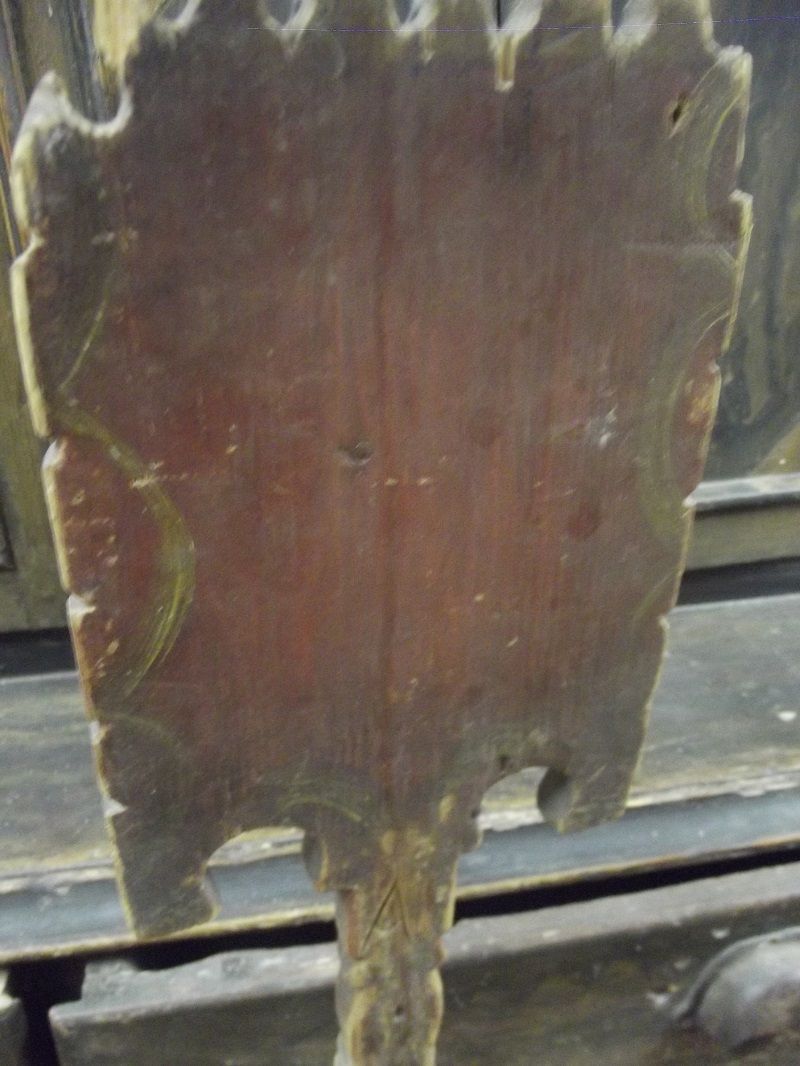
424 D-92: АНА И on the blade front;
426 D-94: ЕАТ АГ on the leg, written in vertical direction;
580 D-105: МГ on the blade back side;
2317 D-183: П.Б.Н.С. Ш ВЛД on the blade back side (Megra);
2895 D-283: НАН … О on the leg, written in vertical direction;
2898 D-286: the blade is decorated with an irregular geometric carving with a round rosace having swirling rays in its center. The figure has inscribed crosses on its edges. The back side has also an ornament with crosses. A skew cross is carved on the blade bottom. Perhaps, it is Х. This spinning wheel was located in a monastic cell of a functional church and was handed over by A.A. Shaleiko;
3235 D-328: П.И.А. МИАЯ ДА on the back side;
3271 D-329: К Е, a cross on the blade back side;
3273 D-331: Н Я Н Б on the front side;
3275 D-333: В Д on the blade front side;
3276 D-334: ПМ К on the leg;
3285 D-342: УМ on the front side, М.М on the back side;
3287 D-344: А.В. П.М. on the front side (kid spinning wheel);
4793 D-454: И Б С.Г. Ф Т М И.А. П Д И М Г and ИА П in a figured frame on the back side (Belozersk);
5529/2 D-524: А П Н МА… ВАА, crosses of various shapes on the blade back side (Belozersk);
5549 D-527: This spinning wheel is from the Shola settlement. Unfortunately, we do not know its owner. This spinning wheel is interested in the way of its decoration combining traditions and new things. It is a root type spinning wheel with its blade of irregular rectangular shape extended on the bottom, three small peaks at the top, and edges with small grooves. Inscriptions are made on the front and back sides of the blade, leg and bottom. Later, it was partly painted. There are orange flowers with white highlights in a deep red frame on the blue background on its front side: four-and-three-petal flowers and one tulip, green leaves. The composition is arranged vertically with a flower above a flower. This pattern is typical for northern painting. Spinning wheels with such patterns in our collection date back to the late 19th – early 20th centuries. We can find similar images on spinning wheels in the collections of the Vashkinsky, Kirillov, Cherepovets museums. One can see П.И.Т. in capital letters in the upper right-hand corner, А.П.К in the center along the right edge, У below, ЕПМ, ПС below along the left edge.
Its back side has a pattern made in the middle of the 20th century. Then in 1940-1950s, wall rugs with unpretentious plots were very popular. Fairy-tale motifs, mermaids, forest animals decorated walls of village houses and city apartments. Our spinning wheel has one of such plots: swans on the waves, a mermaid with blue hair, flowers. Groups of letters АМ ВВА ВЕ АКМИ ВК ИЛ ВП ПИП ИПК are cut under the paint in the lower part of the blade. The leg is also decorated with a Christmas tree and the inscriptions АМ МА. АМ is carved on the bottom.
5550 D-528: СГК ИНП АНС САБ on the back side of the blade, К МБ ГА on the back side of the leg (village of Bubrovo, Artyushino self-governance area, owned by Anna Bogdanova);
5597/1 D-544 Maryina on the blade inner side, М Ю Л on the bottom (village of Akinino, former Georgievskoye local area). As for the inscriptions on it, the explanation is quite simple. Galina Lukina who handed over this spinning wheel to the museum worked in the library in the village of Georgievskoye. She was an amateur-talent team member and often used spinning wheels for performances. Last names of spinning wheel owners were signed on them in order to avoid confusion. This spinning wheel belonged to Yulia Maryina.
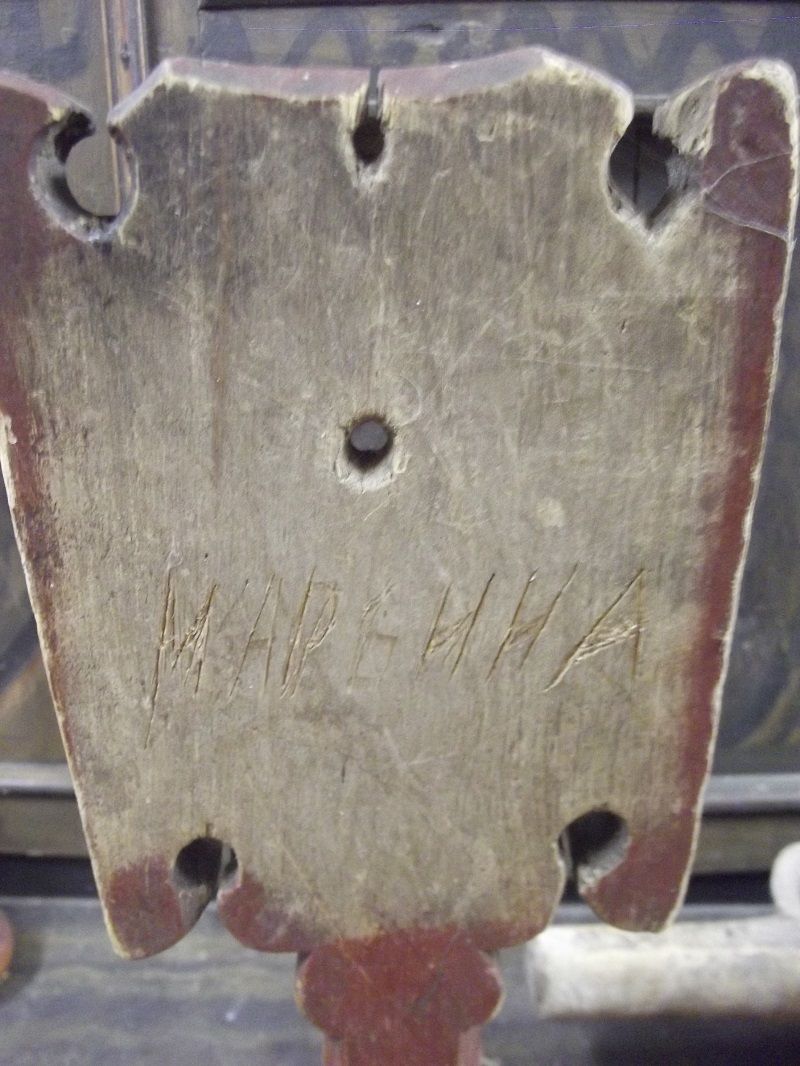
5596/2 D-545: Х Л? А on the bottom (master: Afanasy Bogdanov, 1940, village of Ivanovskoye, former Georgievskoye local area);
5680/12 D-556: А П М on the blade inner side (master: Dmitry Subbotin, 1930-1950s, village of Yesipovo, Glushkovo local area);
5768/4 D-608: В. В. Ф scratched in the center on the outer side of the blade, ПИА БАИ on the bottom on the inner side of the blade (Antushevo local area).
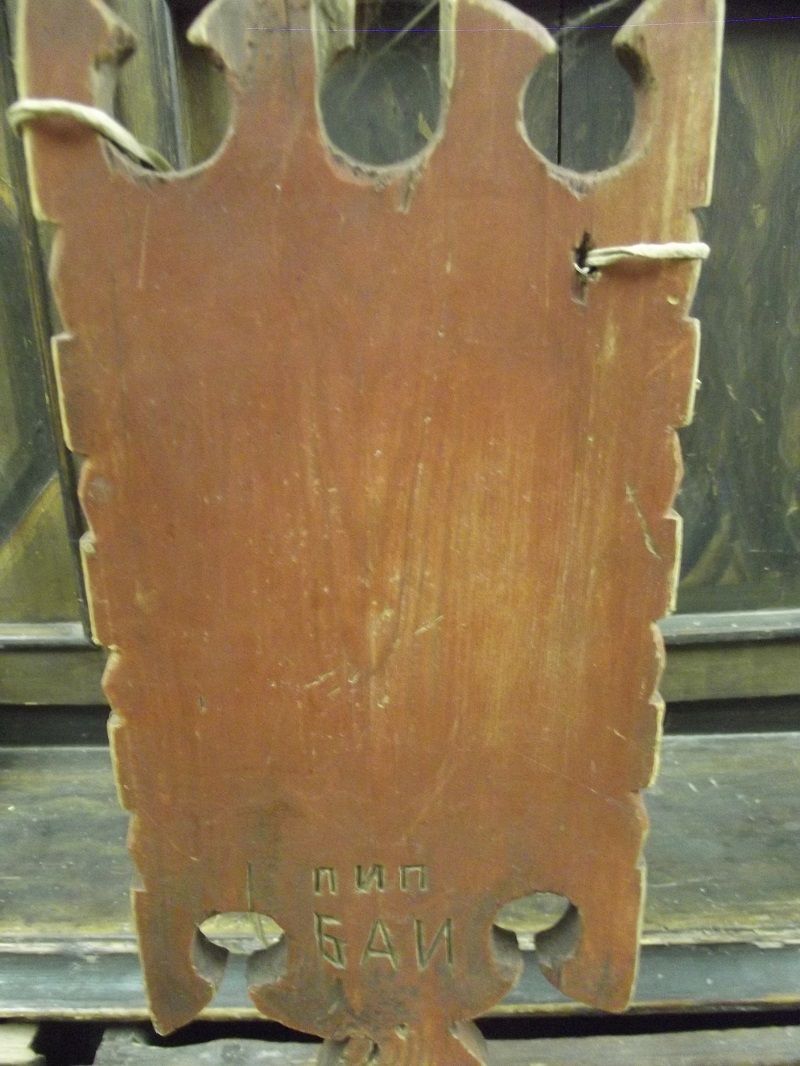
5792 Д -618 «А Я Т» in the center on the leg, А Т on the bottom (Belozersk, from the Tarasovs’ house).
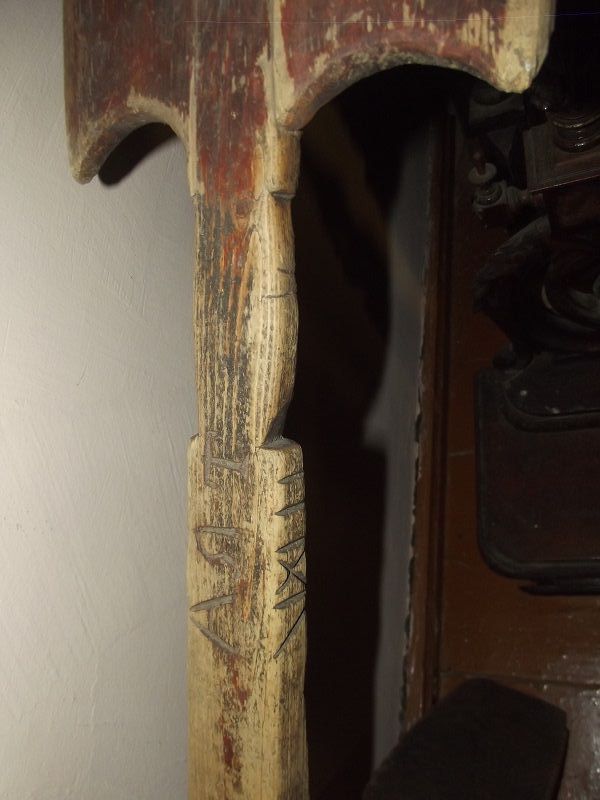
6131/1 Д-665 «А П,» painted by white paint on the inner side of the blade;
6131/2 Д-666 «М», «В», «В» on the bottom on the inner side of the blade;
6139 Д-669 «ИВТ» on the bottom on the inner side of the blade, НТ where the leg crosses the blade (Yenino local area). ГОСКАТАЛОГ.РФ;
27.1579 н/в «Р.Т.Р РС П.М.» on the front side and П М КПП РАС on the back side (village of Glushkovo).
Letters were cut on spinning wheels to designate their owners. Women took their spinning wheels to talk with their friends in other houses and villages, used them during the Christmas merry-making period sliding down as well as during wedding ceremonies. Woman initials were cut out on a spinning wheel to know its owner name. When the spinning wheel was handed over to her daughter or granddaughter new letters were added. Unfortunately, we cannot decipher most of the initials. First spinning wheels received by the museum from the collection of the local history study group were not accompanied by historical data, i.e. the place where the spinning wheel was used, its owner, etc. The owners could not even explain the appearance and designation of the letters on the spinning wheels that were passed down recently.
Last names:
3277 D-335: Al.T.Lobynichev on the front side.
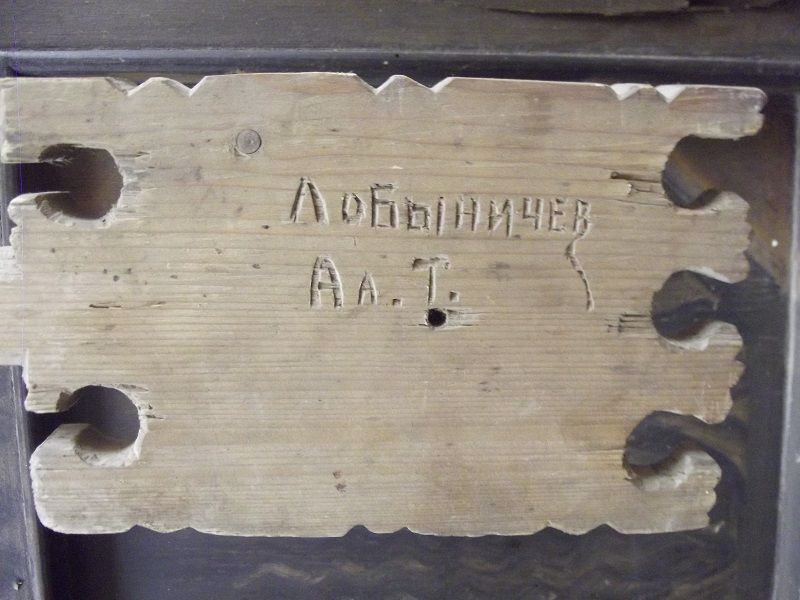
3531 Д-397 Bazlov painted with black paint on the front side;
5502/14 Д-502 Yakov Danilo (village of Borok, Paninskaya local area).
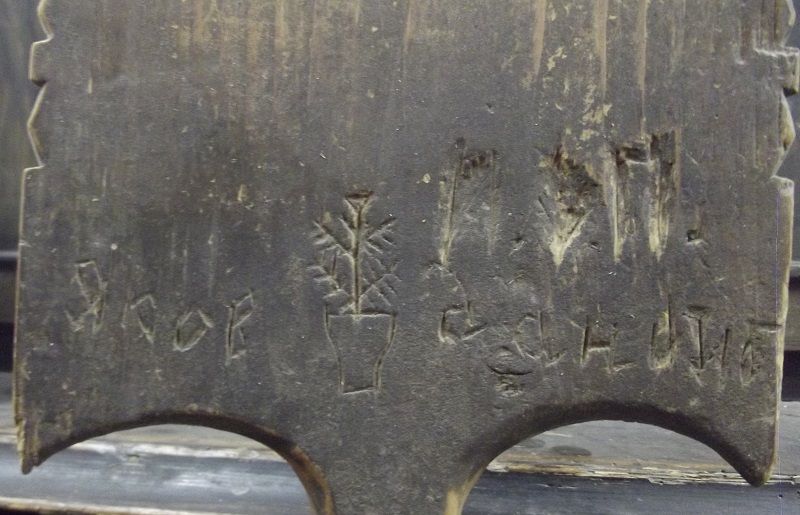
6082 Д-662 «УIWНАС» УIWНАС Ф УСТINНIN on side edges 1380 N.E.Yashov. Probably, such inscriptions include the master last name. ГОСКАТАЛОГ.РФ
Dates:
- 258 Д-49 1895 painted on the back side of the blade. ГОСКАТАЛОГ.РФ;
- 276 Д-67 1889 painted on the back side of the blade. ГОСКАТАЛОГ.РФ;
- 3282 Д-340 «Д. 1929 г. 5/1» on the back side of the blade;
- 5838 Д-620 «1921» on the leg. ГОСКАТАЛОГ.РФ
Mixed:
1577 н/в «Б.Ф 1929» on the front side and, «Быстров Виктор Ф.» «1928» on the back side;
6187 Д- 672 «1923 1 се», «П.В.М» «Х Л.» , «V» (Belozersk district). The inscriptions explain to whom this spinning wheel was handed over or presented. ГОСКАТАЛОГ.РФ;
3234 Д-327 «А.С.В. НАП. (амять) НЮШЕ» on the leg;
3281 Д-339 «НАПАМЕТН ( ять) ПВМУ» «АГ» «ФИ» on the back side of the blade;
3289 Д-346 «В.М.С. Н(а память).ШУРЕ.» on the blade;
5502/52 Д-515 «Федоров Але…й их р..р…и год р..жден… томод…» This inscription was black painted on the front side of the blade and partly obliterated. Later, the pattern was made with oil paint as dots and flowers and letters Е.К were inscribed on the back side of the blade. This spinning wheel arrived to the museum from the village of Gorbusha, Paninslaya local area. Its last owner was Elena Krylova who painted and inscribed it;
6138 Д-668 «Кого люблю тому дарю на память Басовой? Александре» is inscribed with a pen on the inner side of the blade (Yenino local area). ГОСКАТАЛОГ.РФ
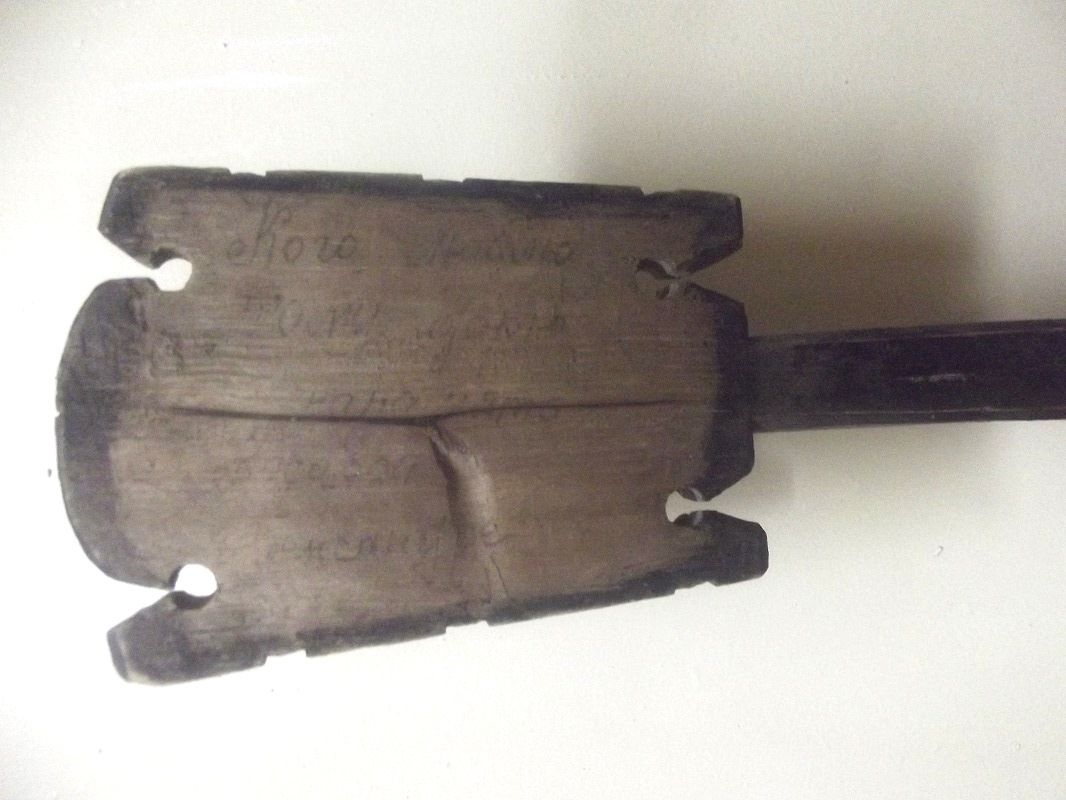
Inscriptions with verbal folklore elements:
1. 264 Д-55 ГОСКАТАЛОГ.РФ : the spinning wheel from the village of Georgievskoye. The shape of its blade and leg is typical of the southwestern part of our region, i.e. it has a compound chiselled leg with very neat edges and a small blade with figured ends resembling animal heads. The front side of the blade and the leg are decorated with a graphic pattern called The Sheksna Gold. An inscription was painted on the leg. Unfortunately, it is partially erased. “My dear .... I didn’t know I fell in love, I fell in love…” We have not yet been able to find an analogue of this inscription.
In addition to understandable letters, the spinning wheels contain coded inscriptions in the form of notches, various geometric figures such as triangles, rhombuses, squares. Some time ago, such inscriptions were easy to read. They informed about the genealogy, time, and the position of the sun. Over time, people repeated these images not knowing their meanings, following the line, its twists and turns. Finding a clue to such messages is an interesting and big job that we still have to do.
